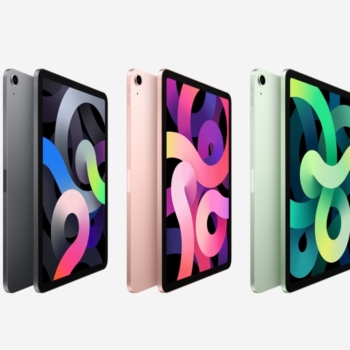The iPad Air 2020 is the very latest model. It is not just an improved version, because Apple has updated almost everything about this model. In this review of the iPad Air 2020 you can read about our experiences with the improvements. And who is this iPad actually intended for?
Introduction iPad Air 2020 review
I have been a fan of the iPad Air since spring 2019 . The model is actually exactly what I need: powerful features and versatile capabilities, without the extra fuss found in the more expensive iPad Pro models . The extra advanced chip and the ProMotion display quite increase the price of the iPad Pro 2020 , while those functions are really not a must for me. The iPad Air 2019 was therefore a godsend: the speed, but not the higher price. The one aspect that I was jealous of was the design of the iPad Pro.
Fast forward to October 2020: the new iPad Air 2020 sees the light of day, with this beautiful design that I have been looking forward to with envious eyes for so long. Now that I have this model in my hands and have been able to test it, this is the ultimate iPad for me. But that doesn’t mean that it applies to everyone. For the average user, the iPad Air 2020 is actually a bit too much. But on the other hand, there are also professionals who can handle this model very well. In this review of the iPad Air 2020you can read our experiences with this sturdy middle class, which has become € 100 more expensive compared to its predecessor. How do you like the new features, such as Touch ID? Does the iPad Air 2020 make the iPad Pro redundant? You can read it in our extensive review of the latest iPad Air 2020.
Design iPad Air 2020: the best of the Pro
- Angular design with flat sides
- Aluminum housing
- Virtually the same dimensions as 11-inch iPad Pro: 247.6 x 178.5 x 6.1mm
- Available in five colors: silver, space gray and the new colors rose gold, green and sky blue
- Wi-Fi model weight 458 grams, slightly lighter than 11-inch iPad Pro
We can be clear about the design of the new iPad Air 2020: we are an absolute fan of the design. Apple has almost exactly the same design as used with the iPad Pro. The flat sides ensure a sleek design and the iPad also fits comfortably in the hand. In fact, we find this design more pleasant to use than the more rounded corners on the previous generation iPad Air and the standard iPad 2020. The only downside is that it is a bit more difficult to pick up the iPad when it is flat on the table. because it is not so easy to get your fingers under the iPad.
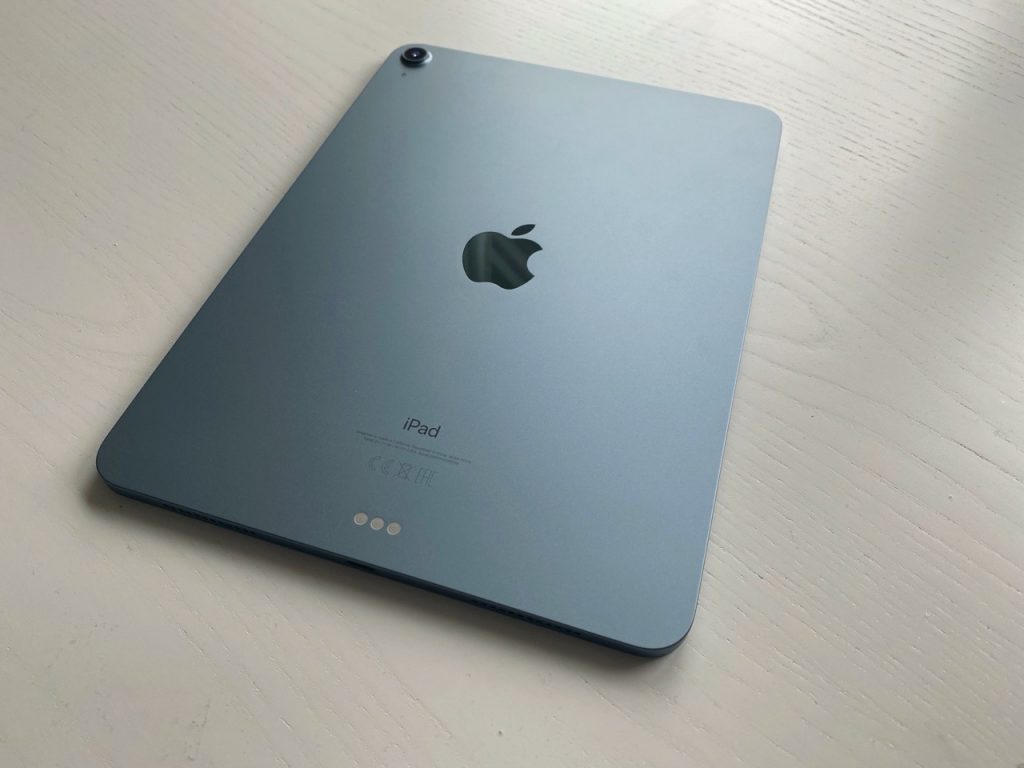
The iPad Air is also nice and thin, but not too thin, which gives you the feeling that you have a fragile device in your hands. When Apple introduced this design in 2018, there were some reports of iPads being easy to bend. We have not experienced this in our test period and we do not feel that we need to be extra careful due to the flat design. Incidentally, the iPad Air 2020 is 0.2 millimeters thicker than the iPad Pro 2020.
Five colors
For the first time, Apple has done a lot with different colors. Normally only the iPhones appear in all kinds of different colors and we only find the standard colors space gray, silver and gold with the iPad. Space gray and silver are still here, but the colors are now also joined by rose gold, green and sky blue.
For this review we tested the sky blue version. We find it difficult to recognize the blue in reallife in this color. Nine times out of ten, the iPad Air appears silver-colored, especially if you have no comparison material. We understand that, given the name of the iPad (“Air”), Apple has opted for light colors and then sky blue also fits perfectly, but in our opinion it could have been a bit darker. In the evening with artificial light, the aluminum housing looks very much like silver. If you ask people on the street what color this is, most people will say silver. We regret that the blue is not slightly darker. As blue as the new iPhone 12 or iPhone 12 Pro is exaggerated, but now the color is very hard to find.
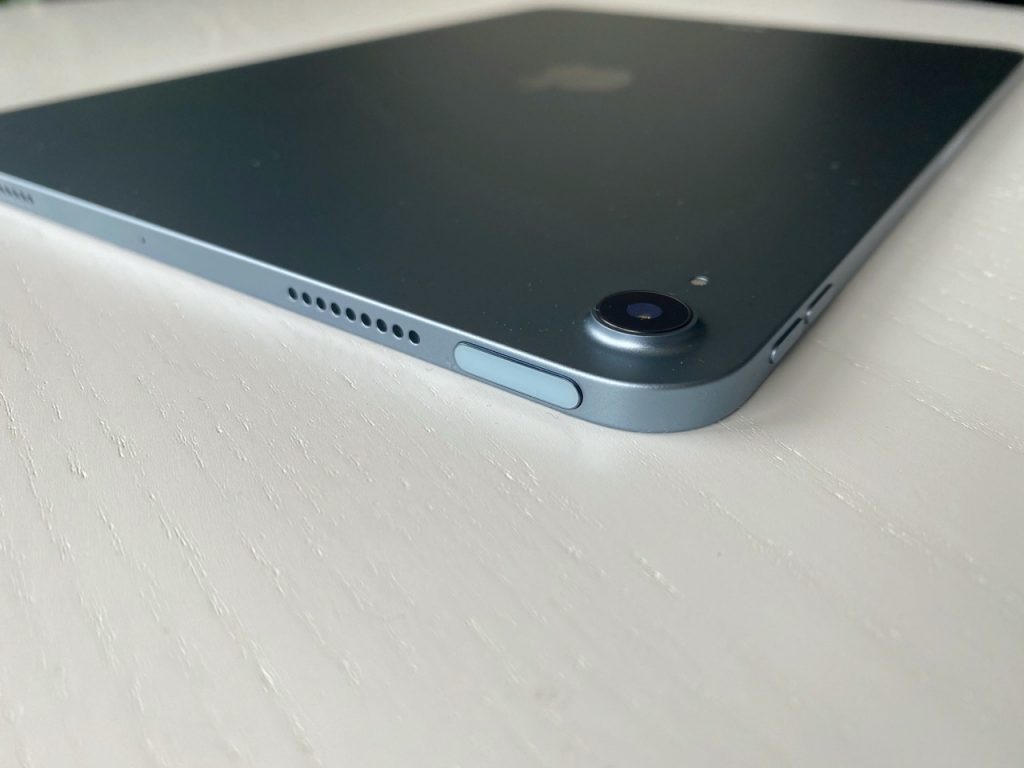
If you want a color that is more distinctive, you have to go with the green or rose gold versions. We have not been able to test these colors, but what we can see from the images, the green version is very much in between the green of the iPhone 11 and iPhone 12 , while the rose gold is a bit more like the earlier rose gold iPhone 6s . We do find it striking that Apple has not opted for the new graphite of the iPhone 12 Pro , but again for space gray.
Screen: Liquid Retina, but just a bit smaller than the ProScreen: Liquid Retin
- Liquid Retina display with thinner screen edges than the predecessor
- 10.9-inch display
- 2360 x 1640 resolution, 264 pixels per inch
- Fingerprint-resistant coating, laminated display and anti-reflective coating
- No ProMotion
At first glance, the iPad Air 2020’s screen is very similar to the 11-inch iPad Pro. That is partly true, but there are big differences. First of all, Apple has opted for a 10.9-inch display. The reason for this is completely unclear to us, because the dimensions of the device itself are identical (except for the thickness). Apple also uses the same screen technology, namely Liquid Retina. This causes the display to extend to the edges. So there is no home button anymore. But because the screen size is slightly smaller and the iPad itself is the same size, there is a small difference in the screen edges: the iPad Air 2020 has slightly wider edges. As far as we are concerned, the difference is minimal and you can only see it if you keep the two next to each other. The difference in screen size is also hardly noticeable, so we think it is strange that Apple has chosen this.
Compared to the iPad Air 2019 , the screen is a significant upgrade. You have just a little more screen space at your disposal, although we find the difference much less noticeable with the switch from the 9.7-inch of the former standard iPad to the 10.5-inch screen of the iPad Air 2019 . It is mainly the idea that the front of the iPad consists almost entirely of a screen that appeals to us the most and not so much the slightly larger size. If you come from an older iPad Air, for example the second generation, or an older standard iPad, then the difference is huge. You really have something completely new in your hands that you will certainly enjoy using the iPad.
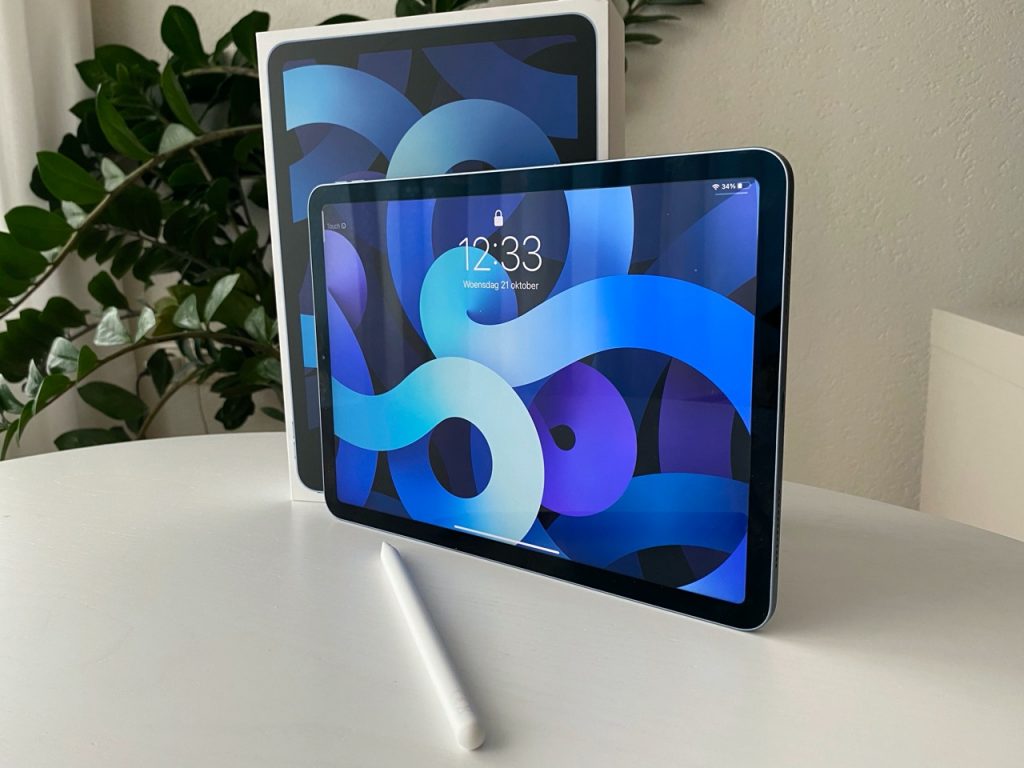
The larger screen also comes in more handy with how we use iPads today. The iPad is more than just a tablet for playing games, surfing and watching movies. Thanks to all kinds of multitasking functions, the iPad has become a laptop replacement for more and more people in recent years, and the larger screen comes in handy in that case.
Various screen techniques supported
We also like that Apple has not cut back on key screen technologies. True Tone and the wide color reproduction are present. In addition, the screen is laminated. With the standard iPad we find that a clear shortcoming, because with a non-laminated display there is so much air between the glass plate and the actual screen. That is not the case with this iPad Air 2020, so you really have the feeling that you are operating everything on the screen directly with your finger (or Apple Pencil).
No ProMotion
The only concession that Apple has made compared to the iPad Pro is the lack of ProMotion . ProMotion is a technique in which the refresh rate increases to 120Hz in applications where it is needed. This makes animations look smoother and scrolling is also more pleasant and smoother. And with the Apple Pencil, you’ll notice that your drawn lines accurately follow the tip of the pen. You don’t have that on the iPad Air 2020. On the one hand, we think this is a shame, because it really makes a clear difference. On the other hand, we find this understandable, because Apple distinguishes the iPad Pro in more areas. Yet we no longer see the differences with regard to the screen with the iPhones : the iPhone 12has the same display as the iPhone 12 Pro .
Touch ID in the iPad Air 2020: back again
- Built-in Touch ID fingerprint scanner for unlocking and authentication
- New location: in the power button on the top right side
- Specially designed for the iPad Air
Over the years, I’ve gotten used to Face ID on iPhone. On the iPad I always used the Touch ID sensor, but actually I always found it inconvenient. The home button is not always within reach on an iPad, especially since you can hold an iPad in all kinds of ways. Where you can blindly find the home button on the iPhone with Touch ID, it is not so easy with an iPad.
Yet Apple has not opted for Face ID with this new model, despite the home buttonless design. The reason for this is not clear, but it may have a price-technical reason. Instead of Face ID , we find a completely new Touch ID sensor, incorporated in the power button. The power button has been redesigned for this. It is slightly wider and the top is shiny, just like the previous Touch ID sensors. In terms of speed, the Touch ID sensor responds just as well as you are used to from the existing sensors. In a few taps you have set up the Touch ID sensor and recognizing your fingerprint takes less than a second. Despite the new shape of the button (oval instead of round as with the normal Touch ID sensors), the fingerprint scanner has no trouble recognizing your finger.

Still, we don’t think the Touch ID sensor on the iPad is ideal, not even here. Due to the symmetrical design, you cannot see where the button is now from the front. Apple has solved this with an animation that indicates where the power button is. This on-screen prompt appears both when unlocking and when using apps with Touch ID . But because of the position of the button, it can be at the bottom left or bottom right, for example, which doesn’t make scanning your finger much easier.
If you use the iPad Air in combination with a keyboard cover, such as the Smart Keyboard or the Magic Keyboard, the sensor is always located at the top left. This is therefore not always convenient for right-handed people. We would therefore rather have seen Apple opted for Face ID. We are a fan of Face ID on the iPad Pro because it always works. It doesn’t matter how you hold the iPad, because Face ID always works. It’s a bit of a search for the Touch ID button.
Two actions to unlock
However, Apple has simplified the actions for unlocking the iPad Air. As soon as you activate the screen (for example, by tapping it or opening a cover), place your finger on the Touch ID sensor. It is then not necessary to swipe up from the bottom to go to the home screen. By resting your finger on the sensor after recognition, the iPad automatically proceeds to the home screen. This gives you time to read notifications on the lock screen, but you also go straight to the home screen this way. As far as we are concerned, Apple has solved this cleverly.
Hardware and performance: the iPhone a small step ahead
- Super-fast A14 chip, Apple’s very latest chip
- Neural Engine for all kinds of processes
- Two stereo speakers in landscape orientation
- USB-C instead of Lightning
- Battery life of about 10 hours
- 12-megapixel front camera, 7-megapixel front
New fast A14 chip
The iPad Air 2020 is the first Apple device that Apple has revealed that contains the new A14 chip. Normally this honor goes to the new iPhones , but the iPad Air was just one step ahead of the iPhone 12 series. In our test we noticed how fast the A14 chip is compared to the A12 chip. When editing photos in Pixelmator Photo, for example, we notice that retouching a photo is a lot faster. Getting rid of an unwanted object is faster than with the previous generation iPad Air and the application of graphic functions in Pixelmator Photo such as ML Super Resolution is also relatively smooth.
The A14 chip is 40% faster than that of the previous generation, according to Apple. Also in the field of graphics, leaps have been made compared to the A12 chip, because these are about 30% faster. The iPad Air can therefore handle intensive games with ease and has no trouble rendering a 4K video or advanced 3D objects in augmented reality.
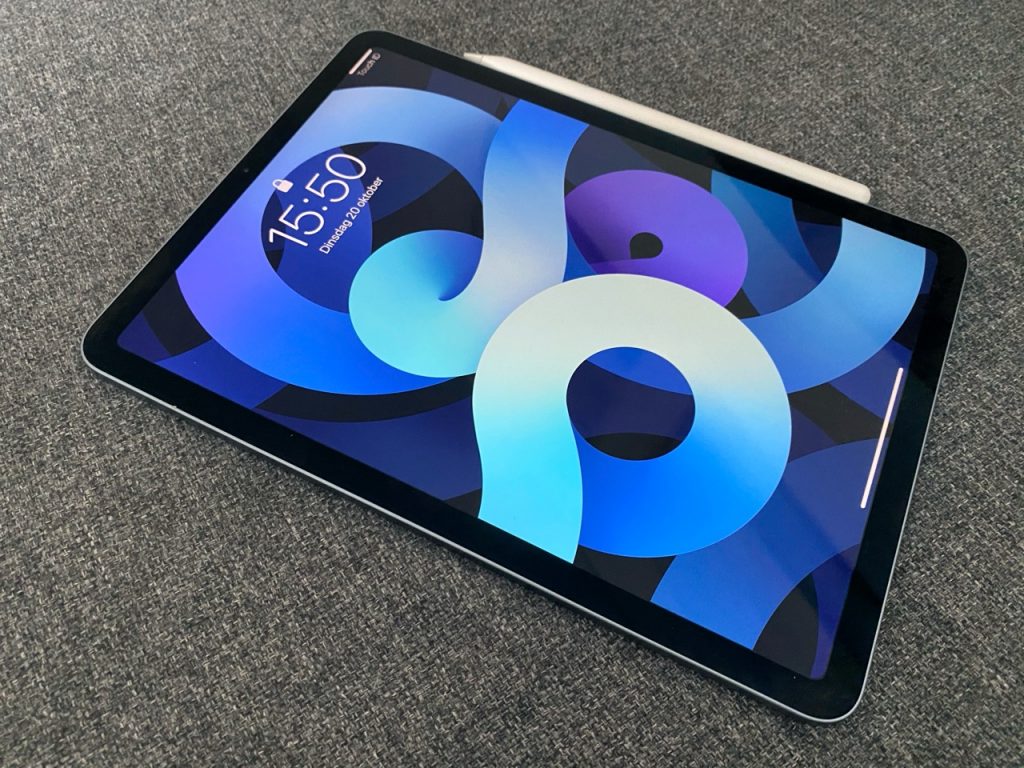
For most people, the chip in the iPad Air 2020 is more than enough. Even professionals who work with photo or video editing can work with this iPad Air. Still, you’re better off with the toughest applications with the A12Z chip of the iPad Pro 2020 , because it is faster and more efficient for multicore applications. Think of video editing in 4K HDR, which on the iPad Pro is still faster than the iPad Air. But in everyday use, we notice that the iPad Air is super fast.
The iPad, for example, has no problem running multiple apps at the same time. For example, we tested this with a spreadsheet in Numbers, by combining it in Split View with the ING Banking app and with a Slide Over calculator from PCalc. You can switch from one app to the other without any problems and switching and adjusting the Split View distribution goes without any hitches.
Two stereo speakers in landscape orientation
Apple has done something special for the speakers. On the iPad Pro models, we have found four speakers since the first generation, where the sound rotates with how you hold the iPad. At first glance it seems as if the iPad Air 2020 also has four speakers, but appearances can be deceiving. If you hold the iPad Air upright, the ‘speakers’ at the top right and bottom right are not real. There are holes, but no sound comes out. Only the top left and bottom left have speakers. Apple describes this as ‘two stereo speakers in landscape orientation’. This means that you only get good stereo sound if you hold the iPad in a horizontal position, for example in a Smart Keyboard.
For most people this will not be a problem, because the iPad is mostly used in the horizontal position. In that case, both left and right sound will be heard and the quality of the speakers is fine in our opinion. We just don’t really understand why Apple has incorporated speaker holes in the other corners of the iPad.
USB-C
Apple has made the switch from Lightning to USB-C for the first time on a non-pro iPad. This means that you can no longer use your existing Lightning accessories and cables without an adapter. With the iPad Air you just get a USB-C charging cable and a 20W USB-C power adapter, so you can charge straight out of the box without any problems. USB-c is also useful if you want to connect the iPad to a recent Mac. Moreover, you can just use the same charger and cable as your MacBook, so in that respect we think the choice for USB-C is actually practical.
Accessories with Lightning are quite rare, except for a few headphones, while more and more USB-C accessories are coming. Think of external drives, which you can now easily connect to the iPad Air. The iPad Air can therefore easily be connected to external displays and other peripherals, making the iPad a bit more versatile than with a Lightning connection. We think it’s good that Apple has already made the switch with the iPad Air. It is only a matter of time before the other standard iPad will follow. On iPhones , we still find Lightning fine, because there is a lot less need for external displays, hard drives and other peripherals.
Battery life
We never find the battery life a problem with the iPad. Apple uses a battery life of about 10 hours and we can achieve that with ease. If you use the iPad for browsing, watching a movie every now and then, and playing a game, you usually exceed that 10 hours of battery life. Only with the really heavy tasks, such as photo and video editing or long FaceTiming or Skype with your colleagues, have we noticed that the battery drains faster. The favorable battery life is also the result of a more efficient A14 chip.
Cameras
The iPad has never been a device with which you take the most beautiful photos and the iPad Air 2020 is no different. The 12-megapixel camera on the back and the 7-megapixel camera on the front are fine for the camera functions you use with the iPad, such as video calling and occasionally taking a photo. But this will not be your main camera for everyday use.
And speaking of video calling , we would have liked it better if Apple had placed the selfie camera on the long side, instead of traditionally seen on the short top. iPads are often used horizontally, especially with a (keyboard) cover. During video calling, the angle with the selfie camera is therefore a bit strange. Moreover, you block the camera more quickly with your hand if you hold the iPad horizontally. For video calling, it is therefore best to hold the iPad vertically, although that is inconvenient if you are simultaneously working on a document or viewing a slideshow in Keynote.

Software: standard with iPadOS 14
- By default, iPad runs on iPadOS 14 , the latest version of the operating system
- Works with most of the new features
- Years of support expected with updates
Apple released iPadOS 14 this fall. Although the promise of a proprietary operating system for the iPad was great, we found the improvements this year a bit disappointing. The main improvements are the new Music app, new navigation in default apps (with special sidebar, similar to Macapps) and the Apple Pencil improvements. You can therefore write anywhere with the Apple Pencil, after which it is converted into typed text. Unfortunately, this only works if you have also added the English keyboard to your iPad and we think that is a shame. In practice, you therefore never actually use it, also because the recognition of Dutch is not officially supported. Sometimes he recognizes words, but still tries to make an English word. Typing is often even faster.
Since Apple added extensive mouse and trackpad support to the iPad earlier this spring , we’ve been using this regularly. In iPadOS 14 , no improvements have been made for this, but nevertheless we find this a nice function. We especially like the flexibility between smoothly switching between a trackpad and touchscreen control and we actually use it quite often. On the iPad Air 2020, this goes just as smoothly as all other iPads.
What you can also assume at Apple is years of support for software updates. That is what makes an iPad so good: you know that it is an investment for the future. With competing tablets, the question is always how long it will last without being slow or dated. I also have an iPad Pro 9.7-inch from 2016 at home, which still works fine after more than four and a half years, can keep up with the latest updates and certainly doesn’t feel slow or outdated. We expect that the iPad Air 2020 will not be any different: if you buy this model now, it will also benefit you in 2024.
Accessories: The latest Apple Pencil and keyboard cover
- Suitable for Apple Pencil 2
- Works with Apple’s new Magic Keyboard for iPad
- Also available: Smart Keyboard Folio
- Smart Folio sleeves in new colors
Second generation Apple Pencil
We are not real drafters, but we still find the Apple Pencil quite pleasant to use from time to time. Even for navigating and using apps as a pointing stick, we sometimes find the Apple Pencil quite useful. The big advantage of the Apple Pencil 2 is that it is more advanced, but also feels better in the hand and charges more easily. We are therefore happy that Apple has opted for support for this second generation, although it does mean that you cannot use your first generation Apple Pencil. We think that’s a shame, especially when you consider that Apple is so committed to the environment and tries to prevent electronic waste. Chances are your first generation Apple Pencil will end up in a drawer somewhere. A better choice is to sell your old Apple Pencil.
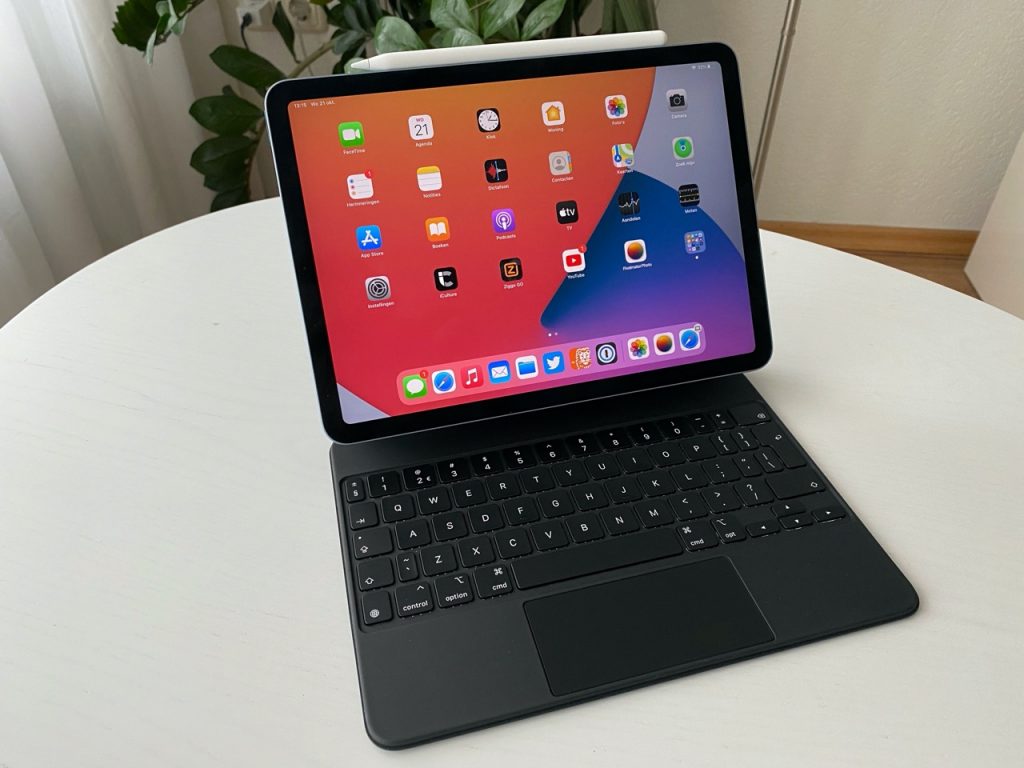
Charging the Apple Pencil 2 is magnetic via the side of the iPad Air. That is a lot more efficient than putting the Pencil in the charging port of the iPad, which looks mostly ridiculous and also quite clumsy. The advantage is also that you never lose the Apple Pencil. You can also easily attach the Apple Pencil to the iPad in combination with the iPad Magic Keyboard.
Magic Keyboard for iPad
This keyboard cover, released for the iPad Pro earlier this spring, has a fully built-in keyboard and trackpad. The 11-inch model of the Magic Keyboard is suitable for the iPad Air 2020 . We have also tested the keyboard with this iPad Air and find that the trackpad feels a bit small and therefore requires some getting used to. We also regret the lack of function keys and an escape key.
Apple’s Smart Keyboard Folio case, which also includes a flatter keyboard, also works with the iPad Air 2020. The model for the 11-inch iPad Pro is suitable while also protecting the back of the iPad. We were unable to test this keyboard cover for this review. We do have the Smart Folio case for this model, in a beautiful dark blue color. In combination with the light blue iPad, we find this a very strong combination. The Magic Keyboard for the iPad is quite heavy, so if we take the iPad somewhere, we find it much more pleasant to put a separate cover around it.
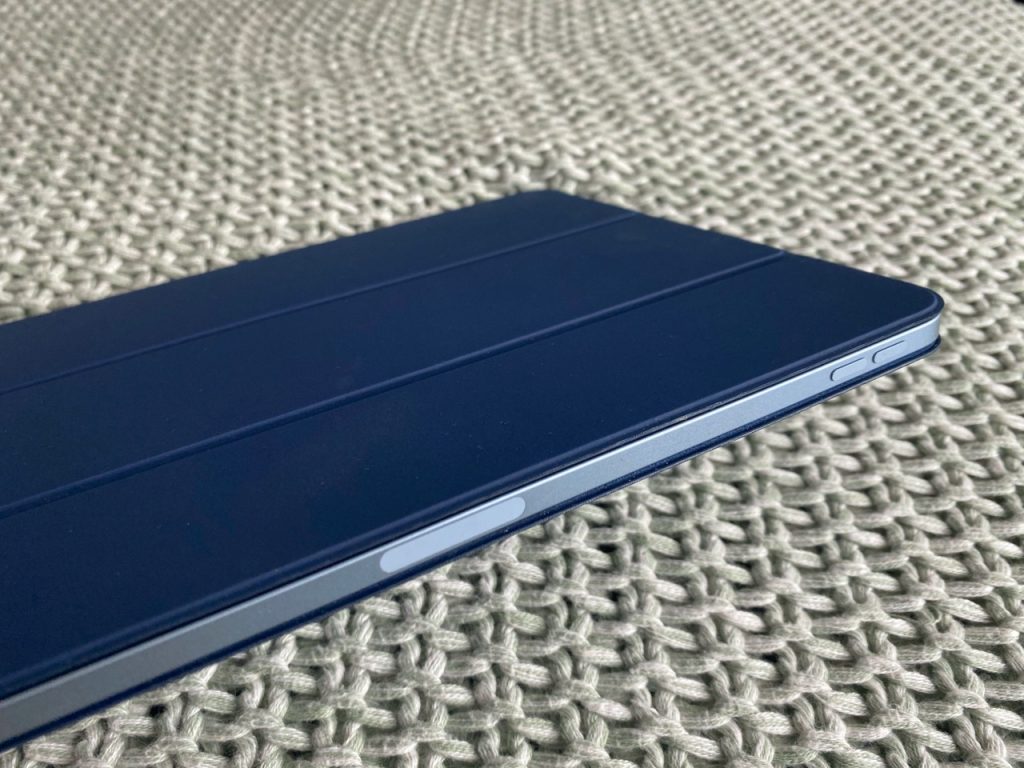
Who is this iPad Air 2020 for?
At the time , we called the iPad Air 2019 a powerful mid-range in the review . This was mainly due to the combination of features and price. The 2019 model was right in between the iPad Pro and standard iPad , both in terms of power and price. In 2020 things are a bit different. The iPad Air 2020 has increased in price by € 100, so you now pay at least € 669 for it. On the other hand, Apple has provided the iPad 2020 with a nice upgrade, making that model just as fast as the iPad Air from 2019. The new iPad Air is therefore a bit more difficult to place.
We think the iPad Air 2020 is best suited for people who are looking for a modern iPad and want to do semi-professional tasks on it, like photo and video editing, use many apps at the same time and more. Creative people can also work best with this model instead of the iPad 2020, because of the support for the second generation Apple Pencil. If you are looking for an iPad to browse, watch a movie or play some simple games, the iPad 2020 will do just fine. For most people this is also the most attractive model, given the price-quality ratio.
We find the choice a lot more difficult for professionals. The iPad Air 2020 will be more than enough for many people, because the differences between the iPad Air 2020 and iPad Pro 2020 have become a lot smaller. Only the dual camera, LiDAR Scanner, support for ProMotion display and the better chip for the really heavy tasks can be found on the iPad Pro.
But is that worth the price difference of more than € 200? We think the iPad Air 2020 is a good choice for many professionals. For the money you save with it compared to the iPad Pro, you can almost buy an iPad Magic Keyboard or a Smart Keyboard Folio, for example.
Conclusion iPad Air 2020
The conclusion of this review of the iPad Air 2020 is clear: the model has been improved in almost all areas compared to the predecessor. The design is nicer, the screen is bigger, the model supports the better accessories and the chip is a lot faster. It is without a doubt the best iPad Air Apple has ever made and in some ways makes the iPad Pro obsolete. The iPad Air offers everything you want in an iPad, although that may be too much for some.
The iPad Air 2020 is in any case a more than worthy upgrade, especially if you look at what Apple has renewed in the iPad Pro 2020 and iPad 2020 compared to their predecessors. The differences there were marginal, but with the iPad Air 2020 it is a difference between day and night. Yet we do have a few things to criticize about this model. For example, we find the Touch ID sensor a bit awkward in practice. We would therefore have preferred a Face ID camera. And speaking of the camera, it is time Apple put the selfie camera on iPads in the long side. Especially now that we are making more and more video calls and there are so many accessories where you hold the iPad horizontally, it becomes clear that the camera at the short top only provides a strange viewing angle.
Nevertheless, the iPad Air 2020 is an excellent successor, although you have to dig a little deeper for that. Whether it is worth it? As far as we are concerned, the cheaper iPad 2020 is also a great choice for many people.
